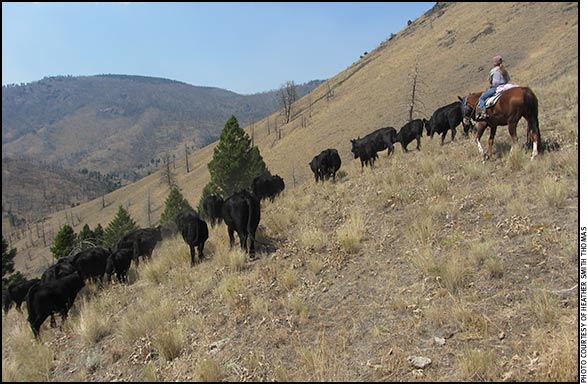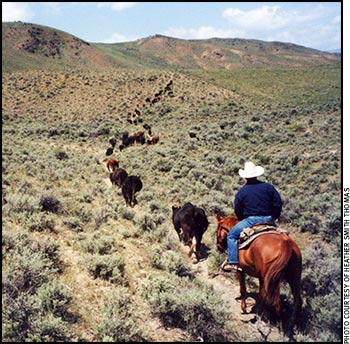
On the Move
Tips on trailing cows and calves to avoid problems.

Travel speed is important; always go cow speed. Horses walk at 4-5 mph, but cows only travel comfortably at 2-3 mph.
A common problem during cattle drives is cows and calves getting separated. Some may try to leave the herd and go to whence they came. The cure for most of these problems is prevention. Chad Cheyney, extension educator at the University of Idaho, offers some thoughts on trailing cows and calves.
- 1. If you want to get the job done quickly, be patient. Somebody once said that if you don’t have time to do it on “cow time,” maybe you don’t have time to do it. Also, if you hurry cattle, you create stress. There are more pairs separated, more wasted energy, and the cattle wear out faster. You actually do get there quicker if you go slowly.
- 2. If pairs become separated, cows usually go back to the last place they saw, nursed or hid their calves. Using the low-stress livestock handling principles taught by Bud Williams and his protégés like Steve Cote will reduce problems by preventing cows and calves from becoming separated as you move them.
- 3. When you first pick up the herd, get the cows up and give them plenty of time to find their calves. Let the cows get the calves up and nurse before you start to move them. Then they tend to stay together during the move.
- 4. Travel speed is important; always go cow speed. Four-wheelers go as fast as the driver wants, which is usually too fast. Horses walk at 4-5 mph, but cows only travel comfortably at 2-3 mph. With young calves, this could be even slower. If your horse won’t walk slowly, slow him down by riding a zigzag pattern behind the cows. Once the herd gets started, it tends to keep moving. Let cattle “string out” and don’t keep them bunched. It’s natural for cattle to trail along following the leaders, and they keep their calves with them that way. In a tight bunch, calves tend to get separated from their mothers.
- 5. The calves are the “weakest link” when moving pairs, so pay attention to their pace and level of stress. If the speed is too fast or the trek is too far, you might have to stop the herd and let them rest and get mothered up.
- 6. Don’t crowd. Cows can see about 270° around, and right behind them is the blind spot. If you are directly behind them, they will stop and turn around to see what you are. This is another reason to ride zig-zag behind the herd, so you are never right behind one cow for very long.
- 7. Well-trained, obedient and quiet herding dogs may be a help in some cases, but usually cattle travel better without dogs. A pack of barking, biting dogs will upset the cows. Any cows that get separated from their calves in the confusion will turn and come back to the rear to look for their calves and fight the dogs that are nipping at the heels of the calves that have accumulated in the drag from being pushed too hard.
- 8. When you get where you are going, don’t just drop the herd and ride off. Spend some time “settling” the cows and making sure everyone is mothered up. When the cows start to lie down or graze and are not all pointed in one direction, like they are about to leave, they are usually “settled.”
- 9. Spend some time watching to see if there are any cows having trouble locating their calves. Assist in getting the pair together. If a calf really isn’t with the herd, let the cow or cows go back and take a look. When the calves are found, cows will probably come back to the herd.

Editor’s Note: Heather Smith Thomas is a cattlewoman and freelance writer from Salmon, Idaho.






